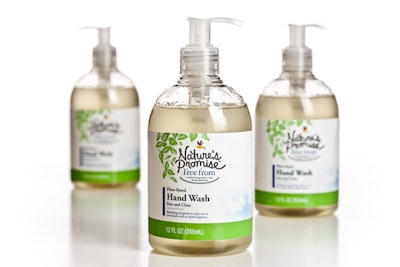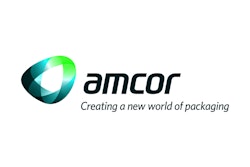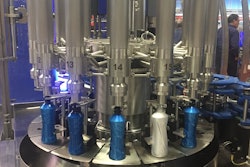A triple threat, Amcor Rigid Plastics’ LiquiForm® game-changing form/fill technology offers consumers higher efficiency, superior container quality, and greater sustainability versus traditional bottle blow-molding and liquid-filling processes. That’s according to Ashish Saxena, Vice President and General Manager of Amcor 360 Packaging Solutions, a service of Amcor Rigid Plastics, whose LiquiForm technology was selected as a Diamond finalist in The Dow Chemical Company’s 2018 30th Awards for Packaging Innovation.
Since 2014, The LiquiForm Group, a wholly-owned subsidiary of Amcor Rigid Plastics, has been making news for its work on LiquiForm technology, which uses consumable liquid instead of compressed air to simultaneously form and fill a container. Combining bottle manufacturing and liquid filling into one step, LiquiForm eliminates the need for blow-molding equipment and air pressure systems—a sea change that not only results in a container with superior material distribution properties, but also offers the potential for a completely new and more streamlined supply chain for liquid products.
Saxena details the benefits of LiquiForm throughout the supply chain: “Let’s start with the raw material itself, which is resin. There are two advantages LiquiForm brings in resin. First, there’s flexibility to use PET, high-density polyethylene, and polypropylene. Second, in a number of cases, the resin consumption can also be reduced, as lighter-weight containers can be achieved through the improved consistency in wall thickness. As you go from resin to the actual container, another benefit is that there is no need for empty container transportation.
“Inside the manufacturing operations, complexity is greatly reduced, as the system is much smaller, simpler, and more flexible. And, because containers are formed and filled with one machine, we are exploring the potential for customers to move production closer to demand. Since the machines are small and simple to operate, customers could move their packaging operations to strategically-placed warehouses, resulting in savings on finished goods transportation.”
The first commercial application of the technology, a bottle for the Nature’s Promise brand of liquid hand soap, launched in December 2017. The bottle is made from PET with 50% post-consumer recycled content and was formed/filled on an Amcor-built machine powered by LiquiForm technology. Delicate embossing of the brand’s symbol—a leaf—on the shoulder of the bottle demonstrates the capability of the technology to create fine details.
“Because of its incompressibility, a liquid is able to provide far better definition onto the mold than air,” says Saxena. “We’ve done several like comparisons, and what we find is that even when you crank up the air pressure to quite a high level, liquid is still able to provide much finer detail—for example, giving a container a texture like an orange peel or adding small engravings like a braille inscription.
“This is one of the things that is attracting brands to this technology, because packaging is ultimately about winning on shelf and with the customer. LiquiForm enables companies to differentiate their packaging and make it more attractive.”
To help customers such as Nature’s Promise bring a LiquiForm-produced package to market, Amcor 360 Packaging Solutions provides an end-to-end service—from package development to full-scale forming and filling—assisting them in optimizing their package design, reconfiguring their supply chain, and streamlining production. For the Nature’s Promise project, the brand’s co-packer provided the product, and Amcor formed/filled the bottle on its proprietary equipment.
Saxena shares that Amcor is working with a number of other home and personal care brand owners to bring to market their products in LiquiForm packaging, with the initial bottles manufactured by Amcor. The hope is that as their container volumes grow, CPGs will eventually bring the technology in-house. “We anticipate a gradual ramp-up in production volumes,” he adds. “People obviously want to start small. It’s the ‘crawl, walk, run’ process that we are likely to see, even with LiquiForm—it’s no different than any other new idea that comes along.” –Anne Marie Mohan



























